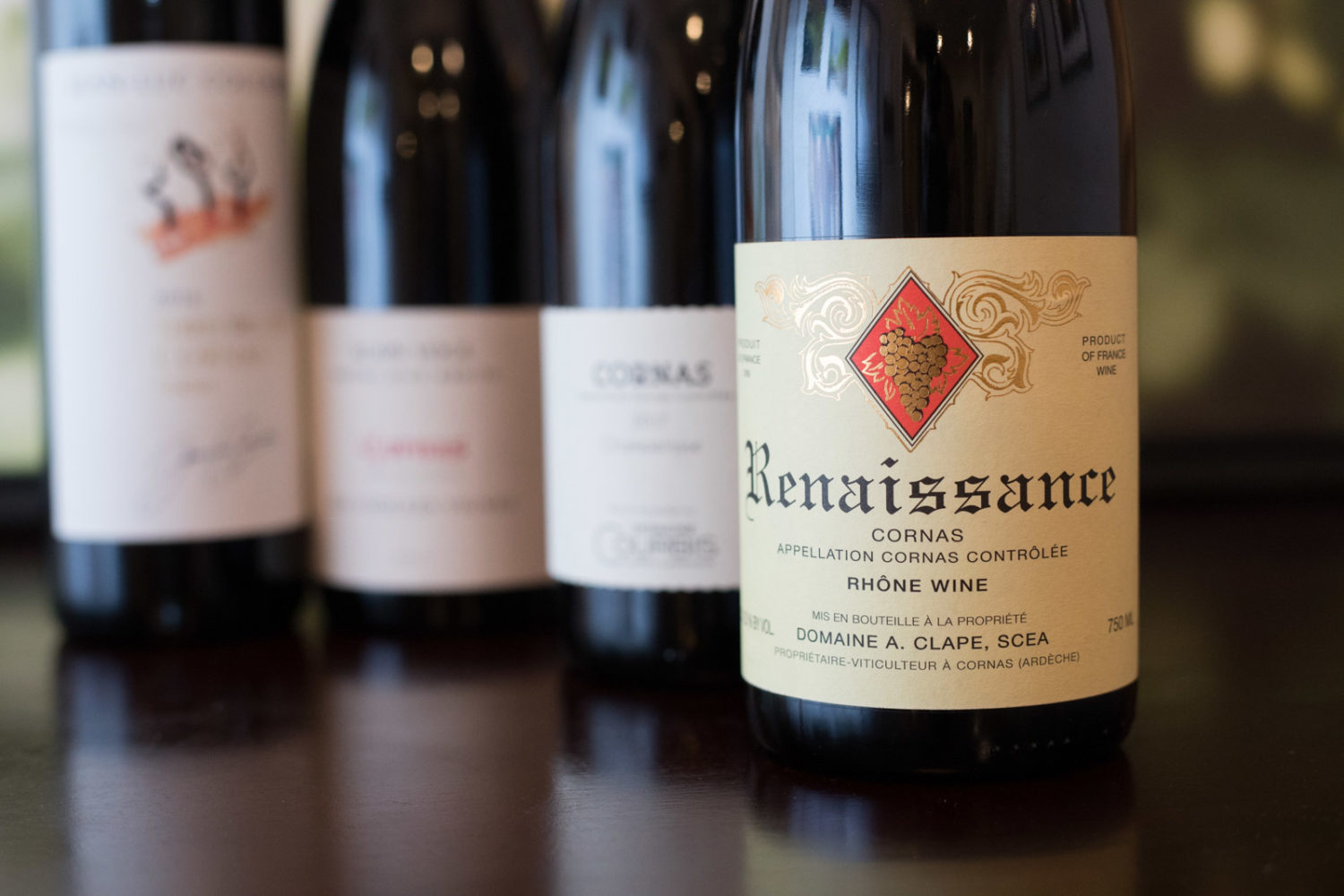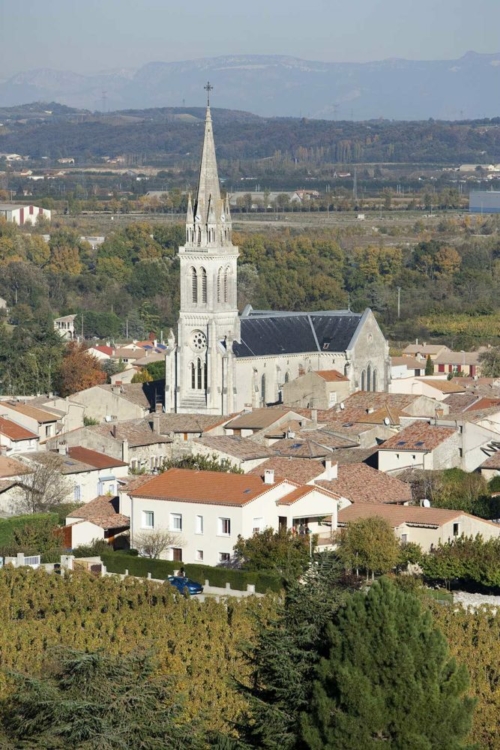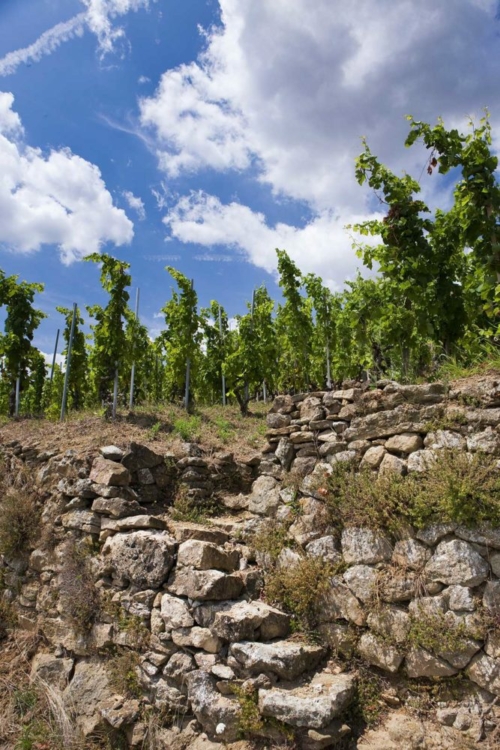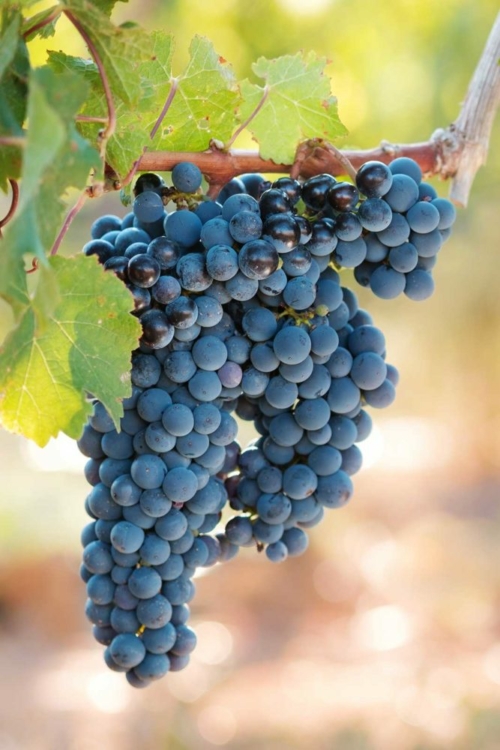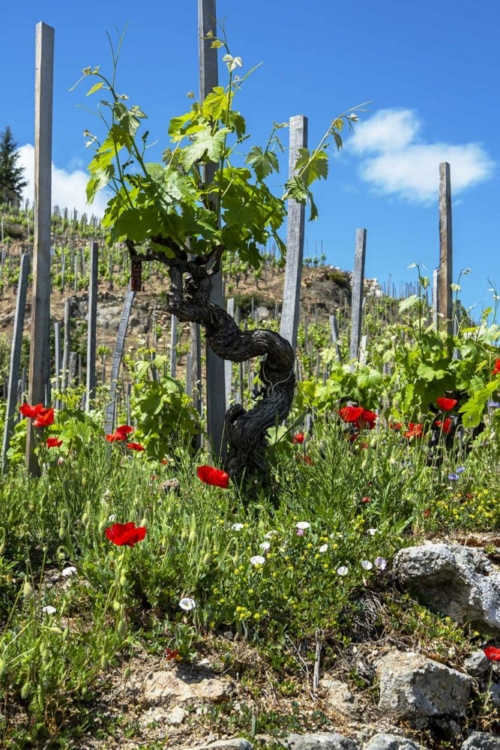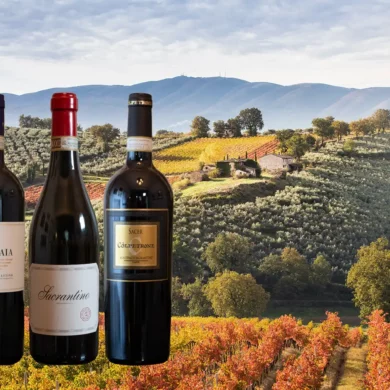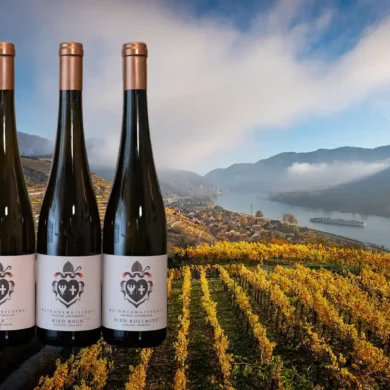Climate change’s ramifications on wine regions are profound in both extremely negative and, sometimes, surprisingly positive ways. For instance, how often have we heard in recent years of a warm winter triggering an early bud-break that is then obliterated by a late-spring frost? Or, of increased wildfires and smoke-taint. Of wineries unable to secure insurance against the increased threats of nature? These stories rightfully belong above the fold in our news feeds, but some places are benefiting from the warmer trends by achieving ripeness in their grapes more reliably. In Cornas — a tiny, Syrah-based appellation along the Rhône River in France — the winegrowers no longer worry about underripe grapes and bitter, astringent tannins in their wines. Nor do they need to educate consumers that their product needs 10 years of aging to be ready to drink. Modern-day Cornas has immediate pleasures while maintaining the ability to age beautifully. In an era when hardly anyone “lays down a vintage,” Cornas hits a certain sweet spot that levels accessibility with seriousness.
If this sounds like a short-term victory, it is. All bets are off as to where many wine appellations will be in the future, including Cornas. But for now, these Syrah-based wines are enjoying a golden age of balance.
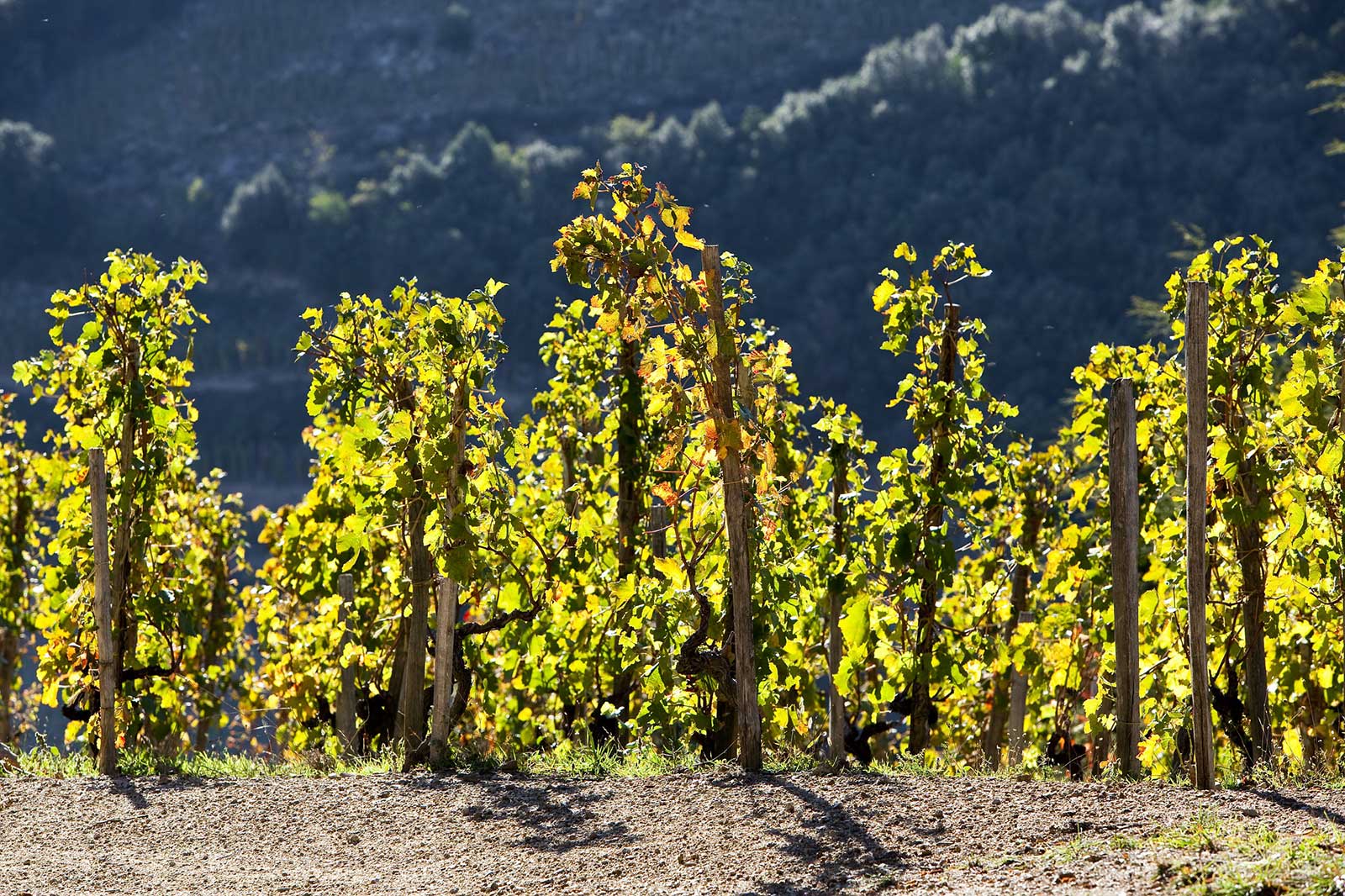
And yes, this is Syrah we are talking about — a red grape that is so thoroughly out of fashion because of a lingering aftertaste of early aughts Aussie Shiraz.
If you are new to Cornas and Northern Rhône reds, do not get hung up on Syrah. Even though it is mandated as a 100% Syrah-based wine, Cornas is more about The Place than The Grape. It is a rugged and undulating landscape largely chiseled in granite. The terrain is diverse, and so are the ambitions of its winemakers. And the wines? Well, at times they may fool you into thinking they are a Burgundian Pinot Noir dressed in the tannic clothes of Malbec. They can smell like olives and bacon as much as blackberries and plums. Rather than being a jammy, fire-breathing dragon, they often saunter gracefully across the palate.
So let’s say hello to this wild, structured and wonderfully savory wine.
What is Cornas AOC?
Cornas (pronounced cohr-NAH) is a protected red wine of origin from a defined geographical area on the western bank of the Rhône River in the Ardèche department of the Auvergne-Rhône-Alpes. Made entirely of Syrah, it is the only red varietal Northern Rhône wine, and differs from other Syrah-focused wines because of its mixture of richness and agility on the palate, as well as a mineral-like finish.
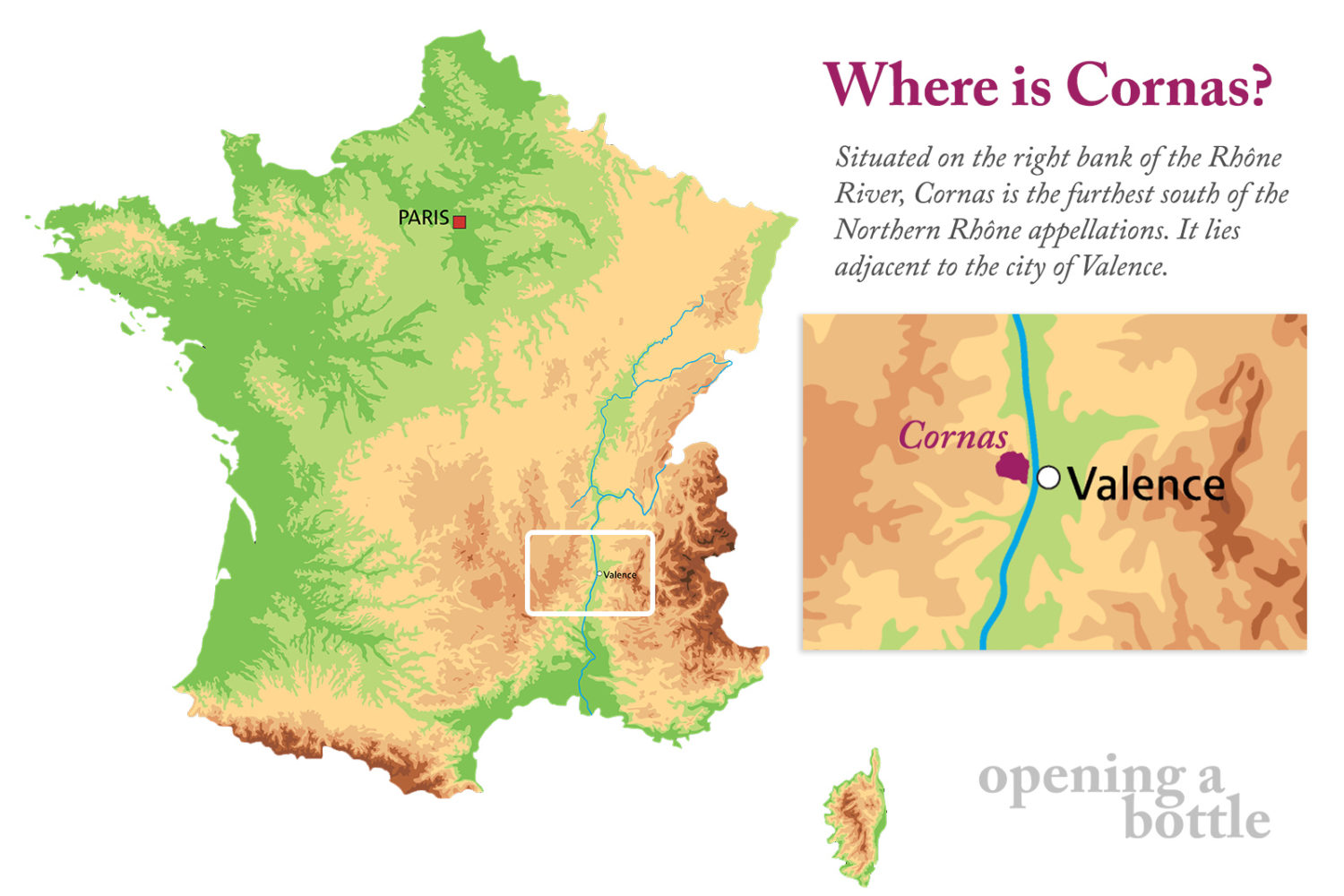
It is not a large appellation: only 110 hectares are under vine, producing roughly 4,000 hectoliters of wine annually. However, within that framework, some of the most coveted red wines in the world are made, most notably from Domaine Auguste Clape, Thierry Allemand and especially the limited stock of back vintages from Noël Verset.
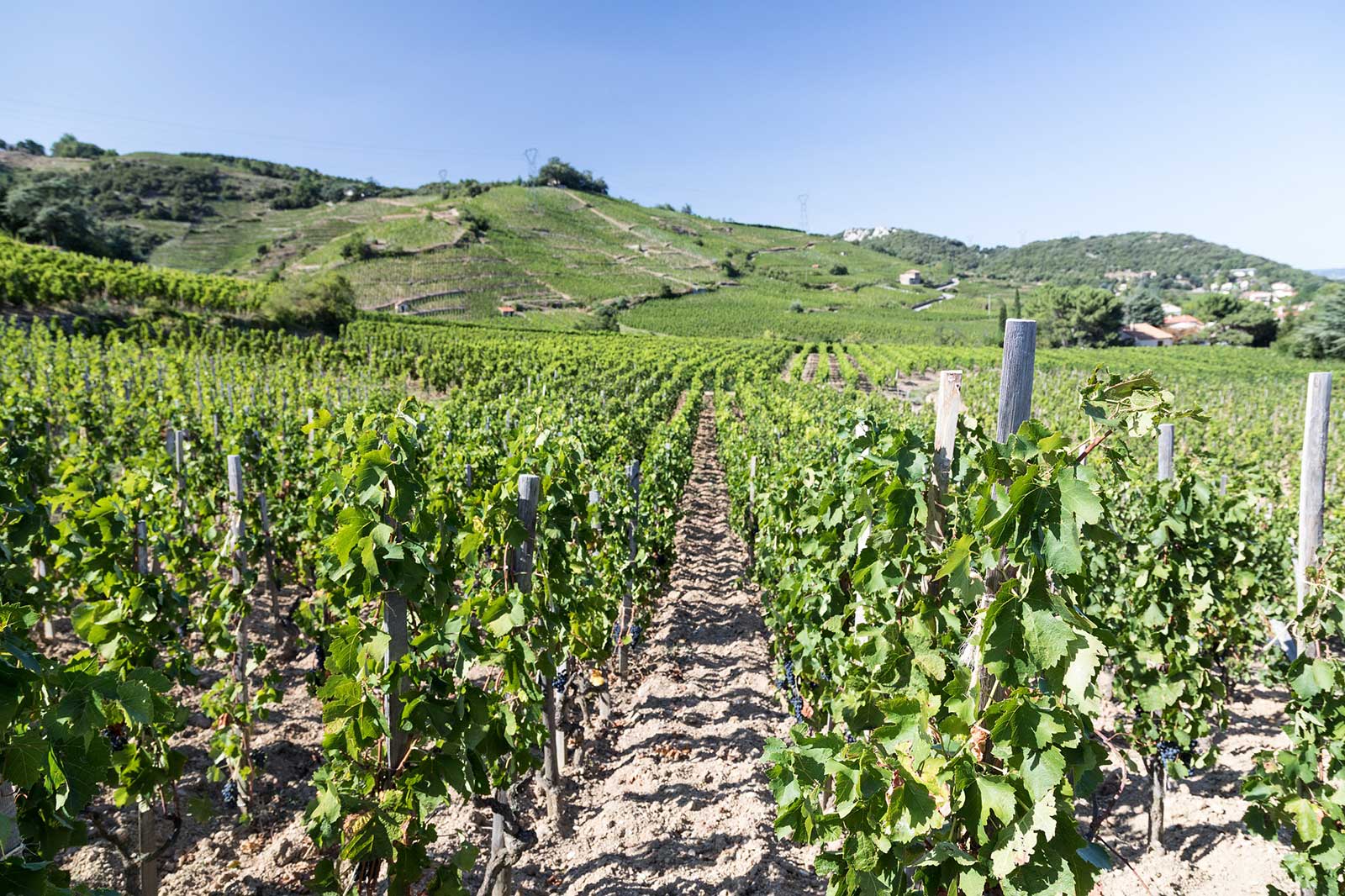
3 Reasons to Try Cornas
- Because of Minerality – You don’t have to be a rock-licker to appreciate the taunt precision of minerality in Cornas’ best wines. This trait — which can appear as the aromas of a rainstorm on the nose, or unify the wine on the finish with a gentle lift like you get with mineral water — is a bit mysterious and its origins are the subject of fervent debate. But it is present in Cornas, and if there is a culprit, it would likely be the region’s granite-based soils. What keeps Cornas’ version of Syrah from running away like a semi-tractor that’s lost its brakes is its abundant minerality. Your mission, with this first taste, is to get acquainted with it.
- Because of Heroes – There are two sides of Cornas, neither of which are noted on the label. One is on the lower reaches facing the river, and while these vineyards offer serviceable Syrah, they hardly scream of place. The other Cornas — the one we want to seek out — comes from the steep hills to the west, where vineyards are labor intensive and the work is “heroic.” Here the rewards of toil are tenfold: well-drained, sheltered from the wind, and ripened by trapped heat, the grapes from this part of Cornas are precious.
- OK, and Because of Syrah – On a global level, this red wine grape is a little like Adam Sandler’s acting career. Many of its stints are not taken seriously, nor should they be: they’re either obnoxiously brash or lethargically flat, and while they once brought in a lot of money, they’re better known for showing up unshaven to premieres in an oversized shirt. They are the wine equivalent of watching Grown Ups 2 and questioning your life choices. But every now and then, you get an Uncut Gems or a Punch Drunk Love — a dramatic turn that is layered, rich, dichotomous, surprisingly deep. And you start to ask yourself, is this actually one of the greatest performers in the wine world? That’s Cornas at its best, and, one could say, Syrah at its best, too.
About the Appellation and Its Wines
Cornas’ name derives from the Celtic phrase for “burnt land.” This romantic name may seem indicative of the heat-trapping amphitheaters found in the hills, similar in intention to another famous Northern Rhône name, the “roasted slope” of Côte-Rôtie. In fact, one of the largest producers of Cornas wine, Jean-Luc Colombo, has run with this and named one of their wines “Terre Brûlées” (essentially, “scorched earth”).
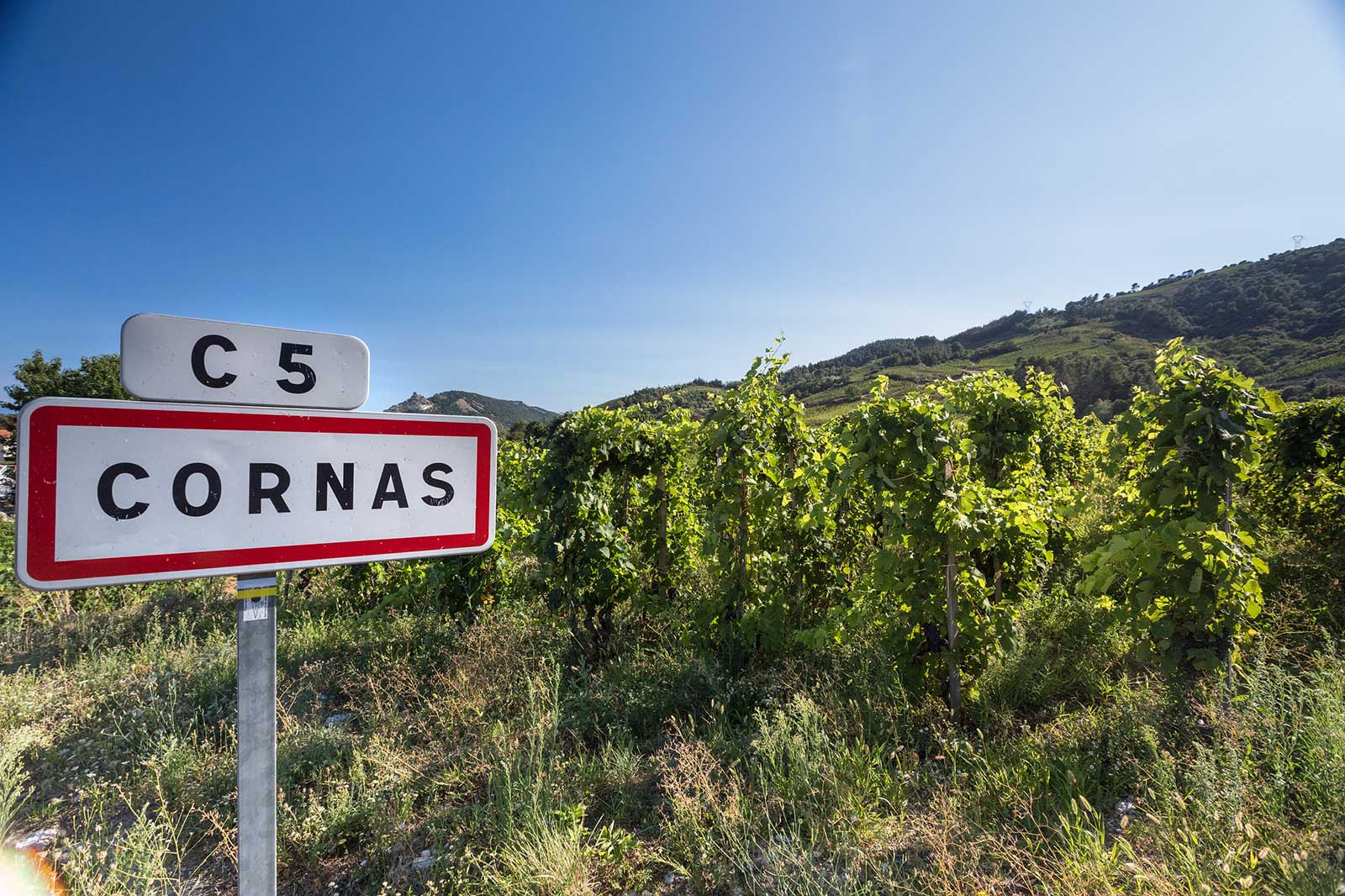
A Challenging Past
Throughout its history, Cornas has made noteworthy wines. Historical records indicate that they were recognized by Louis XV, but they never had the name cache of Châteauneuf-du-Pape or Hermitage, let alone Corton or Romanée-Conti. As we often find when studying places of extreme viticulture — where the terrain makes only lunch breaks easy — fortunes tend to falter at the slightest dip in the economy, or outright plummet in a plague, such as the phylloxera scourge of the late 1800s. The latter was especially hard on Cornas’ vines and the region’s winegrowers.
By 1938, the Cornas AOC was recognized as a distinct appellation of origin in France, but its timing was poor. World War II and the subsequent post-war period made fine wine from the steep slopes unfeasible. Efforts to manage yields, improve vinification, and explore the unique identity of Cornas (let alone market it to an audience beyond the region) were not rewarded by the economic climate. Much of what was grown was sold to négociants for blending. Economic survival was paramount.
But things were brewing. A cadré of winemakers, most notably Pierre-Auguste Clape and Nöel Verset, were beginning to brighten the region’s prospects. Clape was the first to estate bottle his wines, a business decision that was buoyed by the acclaim his wine received from the local priest. Clape found that older vines and longer hang-time on the vine (a risky gambit given the potential for crop-ruining rains) yielded a wine of layered character and stout framework. He held on to traditional practices such as whole-cluster fermentation and the use of large oak casks for aging — practices that continue to this day.
Verset was also fiercely traditional, and his career — which spanned seven decades — helped to stabilize and guide Cornas from rusticity to modernity. As Verset reached retirement, the divesting of his vineyards to Clape, Thiérry Allemand, Domaine Courbis and Franck Balthazar functioned as a passing of the torch in multiples. And the work has inspired a new generation of winegrowers, punctuated by the likes of Vincent Paris and Julien Cécillon, who make needle-threading wines of precision and wild character.
Terroir
There are five principle red-wine appellations of the Northern Rhône, and they are all focused on Syrah: Cornas, Hermitage, Crozes-Hermitage, Saint-Joseph and Côte-Rôtie. Of these, Cornas, Hermitage and Côte-Rôtie are the most focused due to their restricted boundaries, and they offer the most likely glimpse of their respective terroirs.
Cornas stands out for a few reasons. Even though many top Northern Rhône wines are varietal in nature, Cornas (unlike the other four) requires that the wines be 100% Syrah. An even bigger differentiator lies in its position: Cornas is often the first red-wine appellation in the Northern Rhône to be harvested because it is furthest south and it is shielded from the winds. As a result, the wines tend to be richer and more full than Hermitage or Côte-Rôtie.
But the nature of Cornas’ very steep, terraced, granitic hillsides may have the greatest influence on the wine. For one, granite often imparts a unique mineral signature on the finish. This coarse-grained igneous rock radiates heat at the height of day, and quickly cools at night. It drains quickly as well (especially on such steeply pitched slopes), so snowmelt and passing rains penetrate deep into the ground. Lastly, granite is poor in nutrients, so this — combined with where the water goes — means the grapevine roots have to travel deep underground. The plant must work overtime to survive, and this naturally curtails yields, which is important because the grapes each plant offers are concentrated and never diluted.
That said, not everything is uniformly granite in Cornas. Some clay and limestone is present in the northern vineyards, yielding wines of added density and power. To the south, the soil is sandier and more broken down, so the water retention properties are quite different. Cornas from this sector is known to be softer.
Through the center — where you find the two most famous cru, Reynard and Chaillot — you get the perfect balance thanks to a high ratio of granite, and optimum sun exposure and wind protection.
Your First Taste
Cornas sits on a continuum with its New World counterparts on one end, and Hermitage and especially Côte-Rôtie on the other end. Certainly, it veers closer in style to its Northern Rhône counterparts, but it doesn’t have the same tension-born-of-struggle that you find in Côte-Rôtie, nor the elegance in Hermitage. The wines are ripe, structured, tannic, and their complexity seems to derive from a harmony of fruit and savory tones. Make no mistake: the headline is still fruit, while in Côte-Rôtie, it is often meatiness.
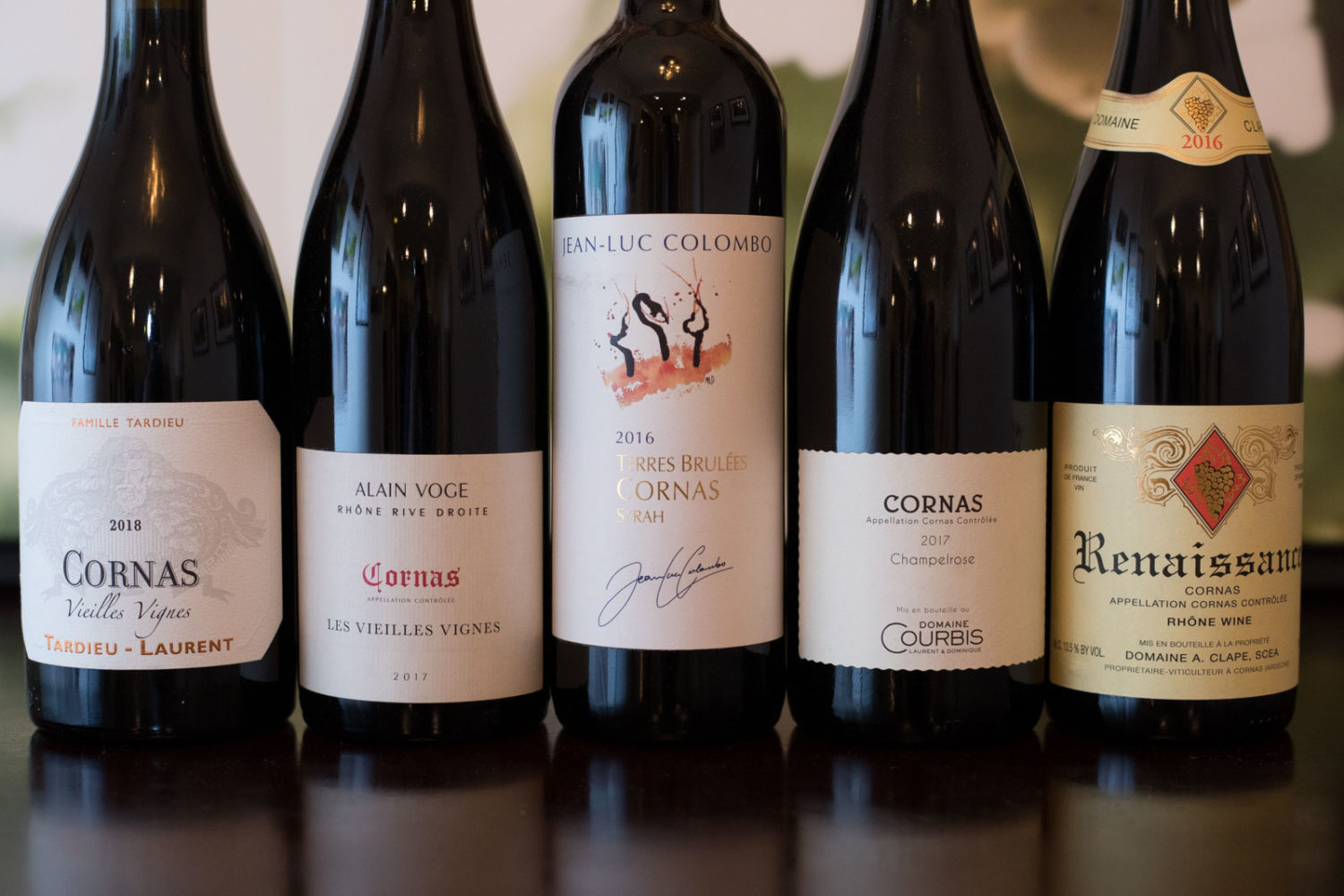
Within Cornas, you have a few towering figures. Thierry Allemand and Auguste Clape are the most sought-after. Allemand is a renowned practitioner of “minimal intervention,” and has steadily acquired some of the best microplots across the middle of Cornas, which he vinifies separately. Meanwhile, Clape blends from numerous plots, a stylistic choice to represent the “true” Cornas by utilizing different aspects of the countryside as ingredients for balance. It is an approach not unlike Chavé in Hermitage or Bartolo Mascarello in Barolo, Italy.
One of the most widely available producers is Jean-Luc Colombo, whose sprawling Rhône portfolio of wines owes a debt of gratitude to Cornas, where he got his start in the 1990s. And then you have insurgents like Vincent Paris (recommended below), and a producer whose wines I have long been fond of, Julien Cécillon. You will also find numerous négociants plying these hills for their mass-appeal wines, such as Tardieu-Laurent and Paul Jaboulet Aîné.
In a blind tasting to craft this guide, I was amazed at how widely the pendulum swung for Cornas. At one end of the spectrum, were soulful wines with a lithe texture and a clean finish that rang like a bell. These wines waltz across the palate. And the other end? Bolder, more brooding versions with a crisp, savory quality that speed-dialed my inner carnivore. Waltz? they seemed to say in a burly voice. Cornas does not waltz.
This stylistic variety can make opening a bottle of Cornas a bit unexpected, but I like the range: one end of the spectrum harkens to the wines of the north a bit with their elegance (even Cru Beaujolais and Côte d’Or Pinot Noir); the other end of the spectrum points the compass south to the chewy, lavishly textured wines of the Southern Rhône. Given Cornas’ geographical position, this “fence sitting” feels appropriate.
I’ve frequented Cornas’ wines on several occasions, and have always found them intriguing. But this was the first time I’d tasted them in close succession and (for the most part) blindly. The exercise showed me that its identity is less singular than what much of wine media portrays; but also, there is a lot to like for a wide variety of wine drinkers. After the tasting, I invited several neighbors over to taste as well, and their favorites were all over the place. Yes, Cornas’ terroir is varied and certainly Syrah is an ideal vehicle for telling the land’s story — at this current time and climate. But the winemaking techniques employed cannot be overlooked.
In the end, which Cornas producer you select depends a great deal on what your vision of this place will be. And so, we are left with two recommended candidates for your first taste (and a third for when you’re ready to explore further).
“I Want to Waltz”
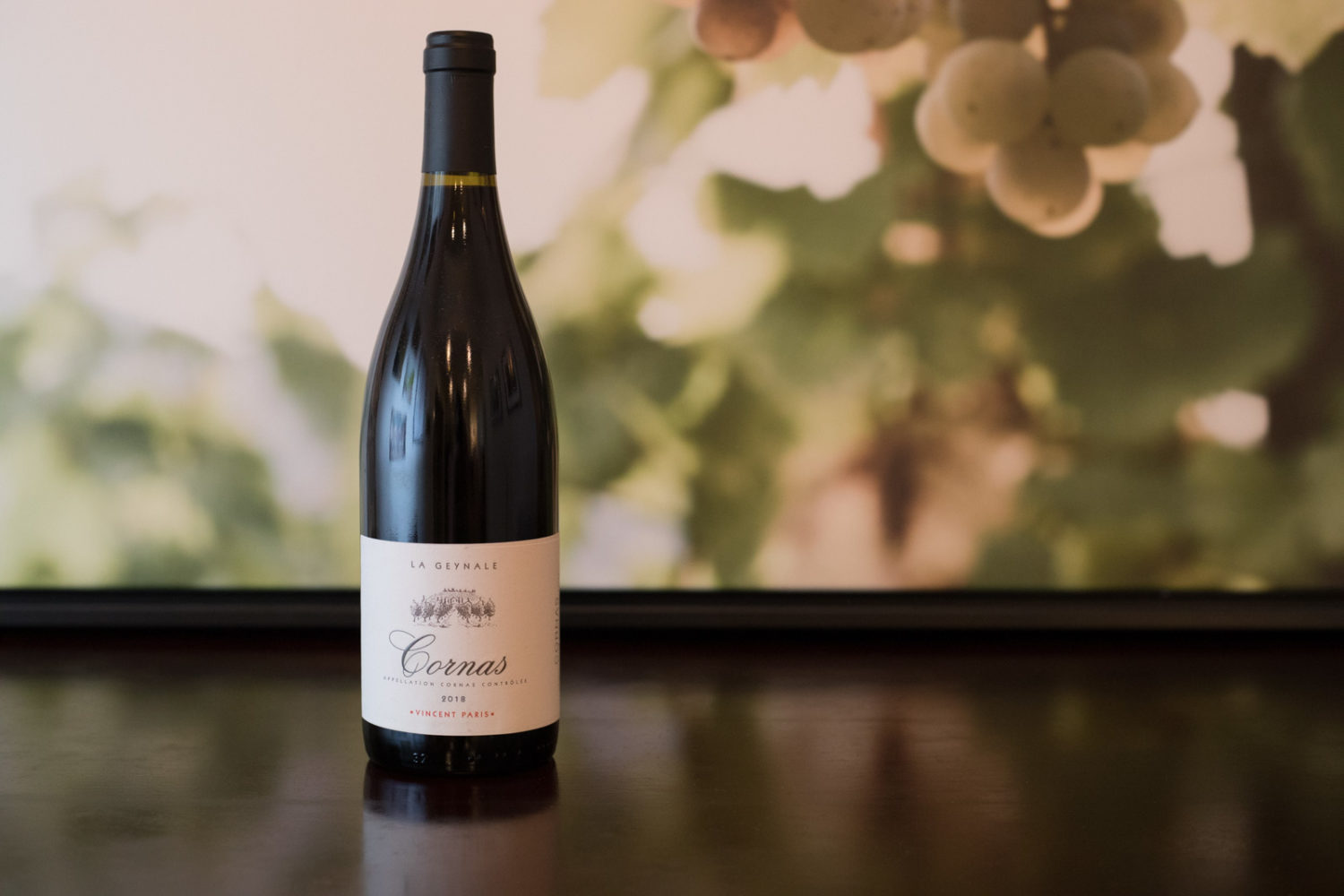
For lovers of Burgundy and sleek, aromatic red wines, the ideal first taste of Cornas appears to be the Vincent Paris “La Geynale” Cornas (★★★★ 3/4) (note: the 2018 vintage was sampled for this story). The fruit tones on the nose and palate are suggestive at times of dark cherries and blueberries, before eventually opening up into a lovely pomegranate tone that is irresistible. Suggestions of violets, hazelnuts and graphite also appeared.
While this nose may be reminiscent of other familiar places, the structure of the wine and its sneaky power brings you back to a Syrah frame of mind. The most important takeaway, however, was the wine’s exceptional minerality, which seems to a tie a ribbon on the whole experience at the finish. You need that on red wines of power to encourage a second sip, and Vincent Paris’ “La Geynale” Cornas has that.
“No, No … Speed-Dial My Inner Carnivore”
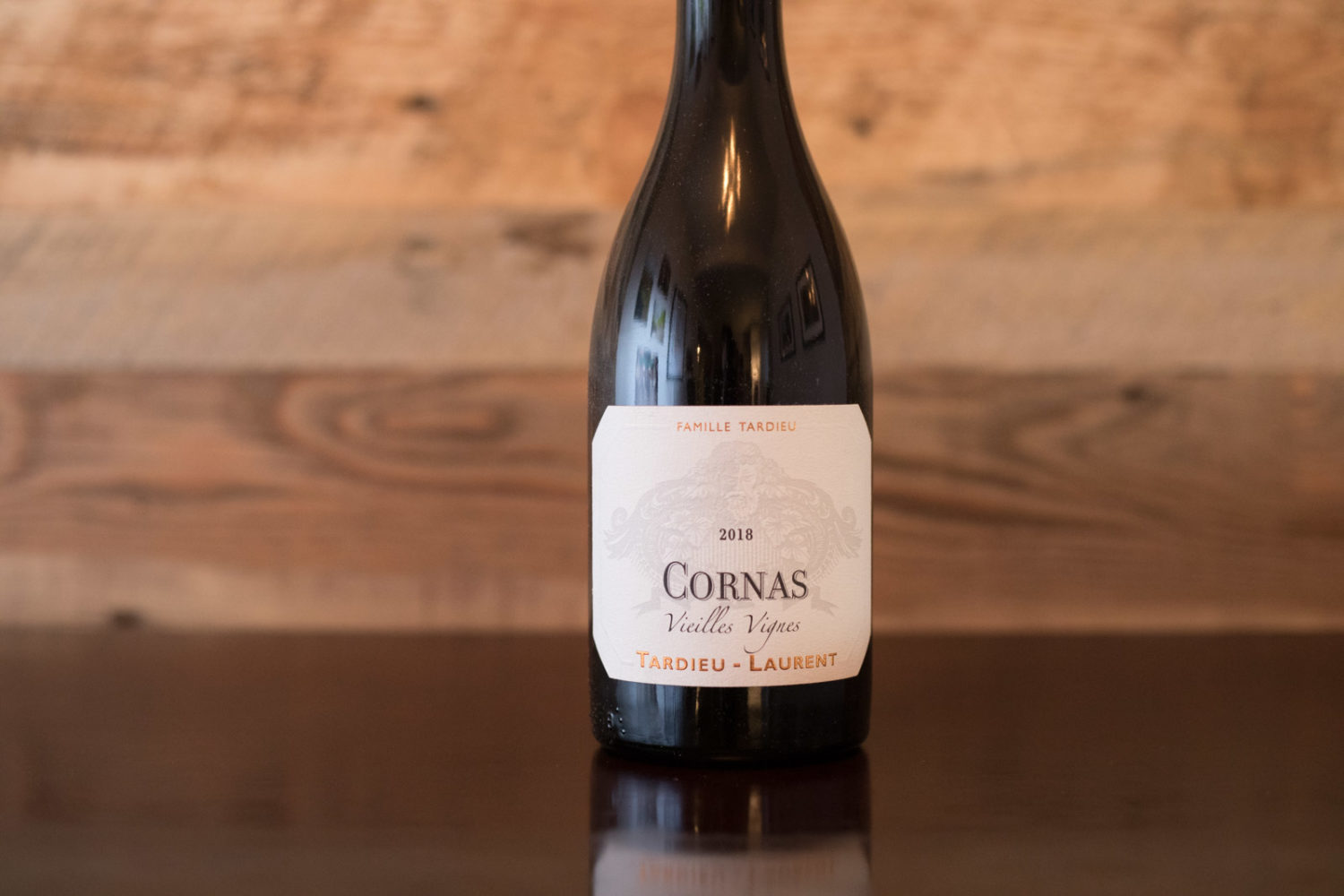
For a Cornas that performs straight down the middle, offering balance and a glimpse of various elements from along the Cornas spectrum, look for the Tardieu-Laurent Vieilles Vignes Cornas (★★★★ 3/4) (note: the 2018 vintage was sampled for this story).
During our blind tasting, this bottle’s reveal was the most surprising, as other wines from this négociant house have struck me as iron-clad and massively structured. Not so, with the old vines Cornas. The tones of black plums, blueberries, coffee, vanilla bean and rose hips will appeal to drinkers more accustom to New World reds, but the distinct lift of petrichor-like minerality (think: the smell of a cooling rainstorm on a hot day) as well as the crackling lightness of the fruit, bring the wine firmly back to the Northern Rhône. But it also had a bit of hedonism to its character: a red wine that I wanted to devour. It’s no wonder that among my non-wine obsessed friends, this was the top vote getter.
“OK, That Was Great. What’s Next?”
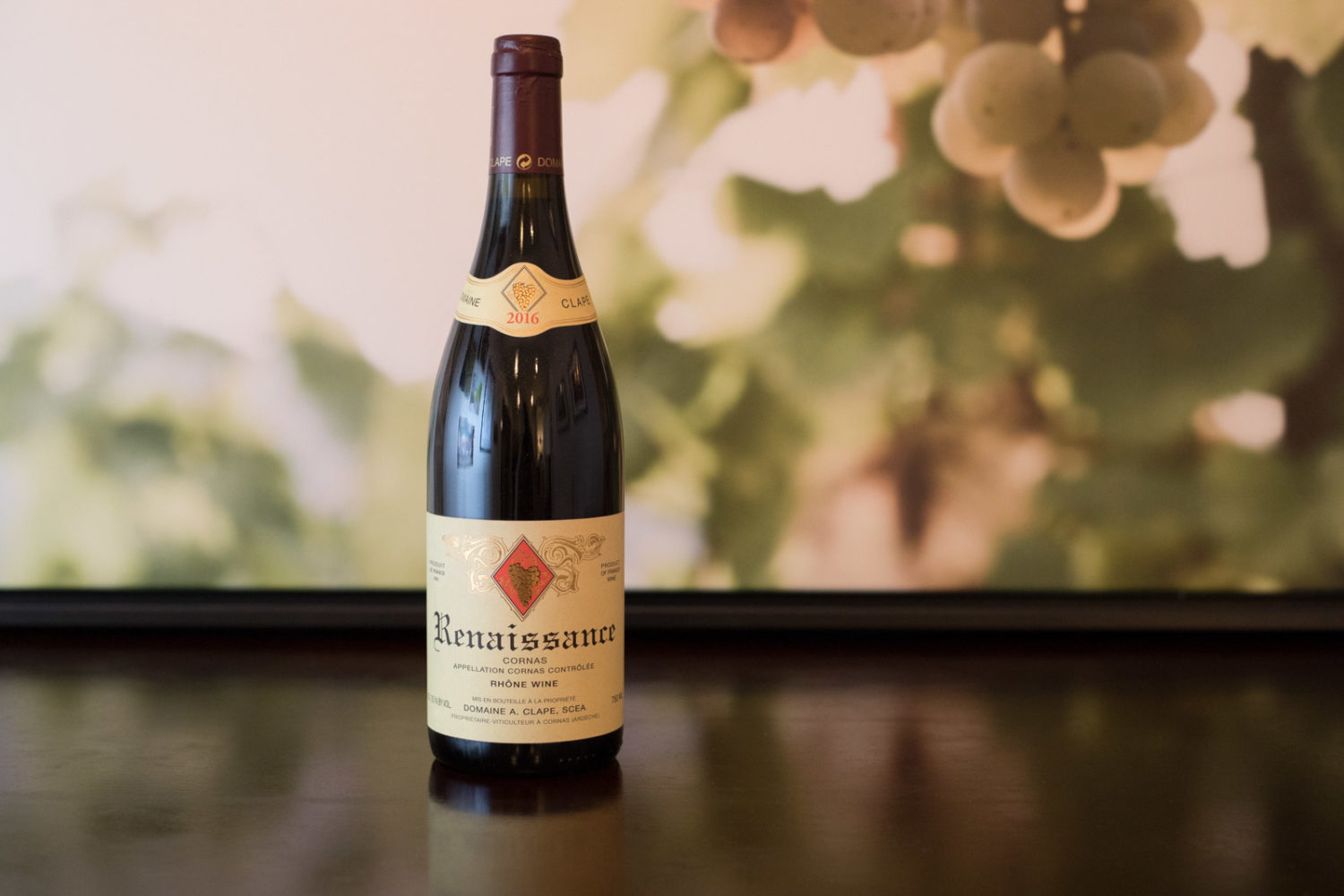
As with many of our first-taste guides, in Cornas, we are not recommending the best wine first. It’s like summiting a mountain by having a helicopter drop you on top: you miss the context and the reward of the climb!
Yet it is still worth noting that the reason Cornas matters is because of producers like Domaine Auguste Clape. What a treat it was to sample their 2016 “Renaissance” Cornas (★★★★★) and encounter the potential of Cornas. Deep, savory, floral and — most of all — precise with its minerality, the wine is simply exceptional. Fans of Italy’s Valtellina Superiore may find shades of ARPEPE’s “Rocce Rosse” in this wine (or is it fans of Cornas may find August Clape in ARPEPE’s “Rocce Rosse?”). Either way, working your way up the ladder to the exquisite Syrah wines of Domaine August Clape is what makes exploring Cornas so rewarding.
Note: These wines were provided as samples by Inter Rhône’s U.S. press agency. The wines of August Clape and Vincent Paris were also tasted separately from the blind tasting. Learn more about our editorial policy regarding samples.

